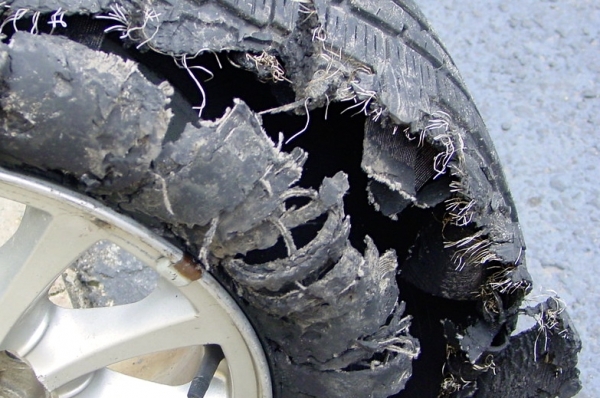Welcome to Crossing Creeks RV Resort & Spa in the heart of iconic Blairsville
If you’re an RV owner who experiences a tire blowout at highway speed, it probably scared you about as much as anything in your life. Even experienced drivers fear the sudden loss of pressure in a tire because of the vehicle control it takes away.
It is possible, however, to control a vehicle when a tire blows—even at speed—if you know what to do. Ironically, doing what you think is right is not always the answer.
How Do Blowouts Occur?
Blowouts aren’t nearly as common today as years ago when tires had tubes. In those days, once the inner tube was breached, pressure loss was immediate and critical—often deadly.
Tubeless tires blow out less often, but it still happens. So do garden-variety flat tires, which remain hazardous, especially on highways with high speed limits and heavy traffic. According to the National Highway Traffic Safety Administration, tire-related problems, including flats and blowouts, caused 738 fatal accidents in 2017, the latest statistic available.
Blowouts occur because of sudden tire failure, sometimes from factors that build up over time. That can be over months, hours or, unfortunately, minutes. Resulting problems can be ply separations, tread disintegration, sidewall fatigue, failure of the bladder (which holds air in the tire), or leaks in the valve or valve stem.
When a Tire Blows at Speed
The best thing to do when a tire fails while you’re driving an RV is counterintuitive. It’s all about physics—about real science, not gut feelings. Don’t hit the brakes or immediately slow down, reactions that many people believe are best. Instead, press the accelerator to maintain or, if possible, increase speed.
A flat tire will slow your RV, but with somewhat erratic control as it exerts a force to whatever side has the flat. So, for example, if a right tire blows—either front or rear—you’ll feel a pull to the right. You’ll sense a rear-tire failure in your seat; you’ll feel a front-tire failure in a stammering message from your steering wheel.
A study done by leading tire maker Michelin for the Recreational Vehicle Industry Association with a lesson placed on video shows that accelerating allows the forward force of the RV to better overcome the sideways force. You’ll have to make a lot of steering corrections to maintain control—you’ll really wrestle with the wheel. Once you reach a safe place to pull over, signal and gradually slow and steer to the side of the road. There, you can change the tire yourself or call for a service truck.
How To Avoid Blowouts
It’s best to avoid blowouts in the first place. The leading causes of blowouts are overloads and under inflation. Don’t overload your RV. Don’t underinflate your tires—or overinflate, either.
There’s no guarantee that you’ll never experience a blowout, but doing these things will help to avoid one:
- Buy quality tires. Search online for reviews of any tire brand and model you’re considering. Make sure it’s a real review, not just praise trumped up by a tire dealer trying to make a sale. Also check the NHTSA for recalls and complaints.
- Look at ply ratings. Most tires have two or three sidewall plies, but those for heavier vehicles and trailers have higher ply ratings indicating more sidewall strength. Load Range B is merely two plies and impractical for trailers, tow vehicles or motorhomes. Load Range C is a 4-ply rating and still often inadequate for the stresses of heavy loads. Better are Load Range D (6 ply-rating), E (8-ply rating) or F (10-ply rating).
- Make sure your tires are rated for proper load. Consult a standard load table. Check your load per axle on a truck scale. Evenly distribute weight as much as possible. And remember: Full tanks add hundreds of pounds to your load.
- Check your tire pressure before a trip—and every morning.
- Inflate to the manufacturer’s recommended pressure. Remember that driving in high altitudes may require extra air, since pressure in the tire will drop as you climb.
- Maintain your tires. Rotate them at least annually, or every six months. Maintain proper pressure. Make sure tires are balanced.
- When you’re parked, use covers to shield tires from degradation caused by the sun’s UV rays, especially in the Sun Belt.
Take your time, particularly if you’re not overly experienced at driving or towing an RV. If you’re going a little slower when a tire blows—55 or 60 mph instead of 75—reacting to it will be easier. And keep a longer distance between you and the vehicle ahead of you, which gives you an opportunity to accelerate in the event of a blowout.
Photo Credits: Flickr.com
Leave a comment
Make sure you enter all the required information, indicated by an asterisk (*). HTML code is not allowed.
